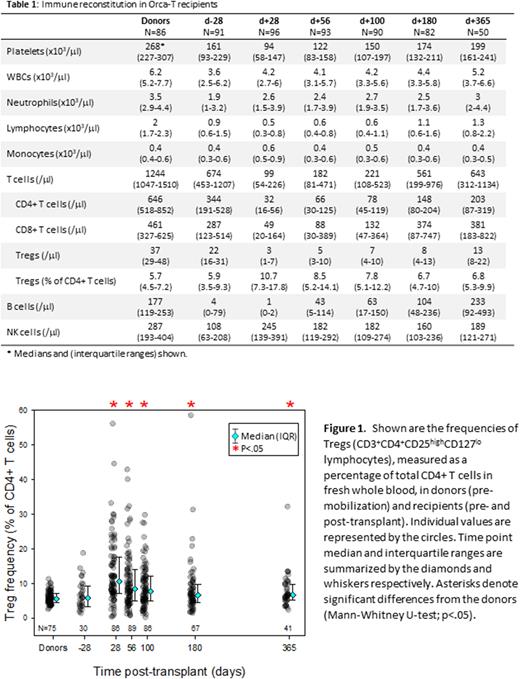Abstract
BACKGROUND Immune reconstitution following myeloablative allogeneic hematopoietic stem cell transplant (MA-alloHSCT) is significantly delayed for T cell depleted allografts when compared to T-cell replete allografts, a feature that has been implicated in higher rates and grades of infection, less GVT, and worse overall survival. Orca-T is a high precision cell therapy currently being investigated for the treatment of certain hematological malignancies otherwise treated with MA-alloHSCT. The cellular drug products of Orca-T (HSPCs, Tregs, and Tcons) are administered at high purity, in controlled doses, and on an established schedule with the intent to reconstitute the blood and immune system while controlling GVHD. Here, we present data on the immune reconstitution in 100 adult patients who received Orca-T.
METHODS In the context of an ongoing multicenter Phase Ib clinical trial of Orca-T in recipients with hematologic malignancies (NCT04013685), we performed longitudinal measurements (days -28, 28, 56, 100, 180, and 365 post-transplant) of immune reconstitution in the first 100 consecutive patients. With fresh whole blood, clinical 5-part leukocyte differentials were performed at clinical sites, and lymphocyte subset frequencies were measured by flow cytometry in a central lab. Principal component analysis (PCA) was performed to investigate potential associations with recipient sex (male vs. female) and donor relation (related vs. unrelated).
RESULTS Longitudinal peripheral blood counts of platelets, WBCs, neutrophils, lymphocytes, monocytes, T cells, B cells, and NK cells are presented in Table 1. T cell and B cell counts were readily observed at days 28 and 56 respectively, and increased with each subsequent time point. Median NK cell levels were observed to be in the normal range at all post-transplant time points. CD4+ T cell and Treg cell counts exhibited similar post-transplant patterns with both being appreciably present at d28 and increasing with each subsequent time point. Strikingly, relative to the level measured in 75 corresponding PBSC donors, the Treg frequency among CD4+ T cells was significantly elevated at all time points post-transplant (Figure 1). Median CD8+ T cell counts increased for the first 6 months post-transplant and then plateaued in the normal range. Upon PCA, very few significant differences were observed in 2-group comparisons of recipient sex and donor relation.
CONCLUSIONS Orca-T patients exhibit early immune reconstitution of each of the major leukocyte and lymphocyte subsets hypothesized to control relapse and infection. Concomitantly, elevated Treg frequencies were also observed. This feature of immune reconstitution profiles of Orca-T recipients may be correlated to the reduced occurrence and severity of acute and chronic GVHD in these patients (Meyer et al., EHA 2022, #S237). Similar immune reconstitution profiles were observed in patients of disparate sex and regardless of donor relation. Prospective comparisons of immune reconstitution between Orca-T and standard-of-care patients will be performed in our ongoing phase 3 clinical trial (NCT05316701).
Disclosures
Meyer:GigaGen: Other: Co-founder, scientific advisor; indee labs: Membership on an entity's Board of Directors or advisory committees; Triursus Therapeutics: Other: Co-founder, scientific advisor; Orca Bio: Research Funding. Killian:Orca Bio: Current Employment, Current equity holder in private company, Current holder of stock options in a privately-held company. Pavlova:Orca Bio: Current Employment, Current holder of stock options in a privately-held company, Research Funding. Bader:Orca Bio: Research Funding. Summers:Orca Bio: Current Employment, Current holder of stock options in a privately-held company. Teque:Orca Bio: Current Employment, Current holder of stock options in a privately-held company. McClellan:Orca Bio: Current Employment, Current equity holder in private company, Current holder of stock options in a privately-held company. Fernhoff:Orca Bio: Current Employment, Current equity holder in private company, Current holder of stock options in a privately-held company.
Author notes
Asterisk with author names denotes non-ASH members.


